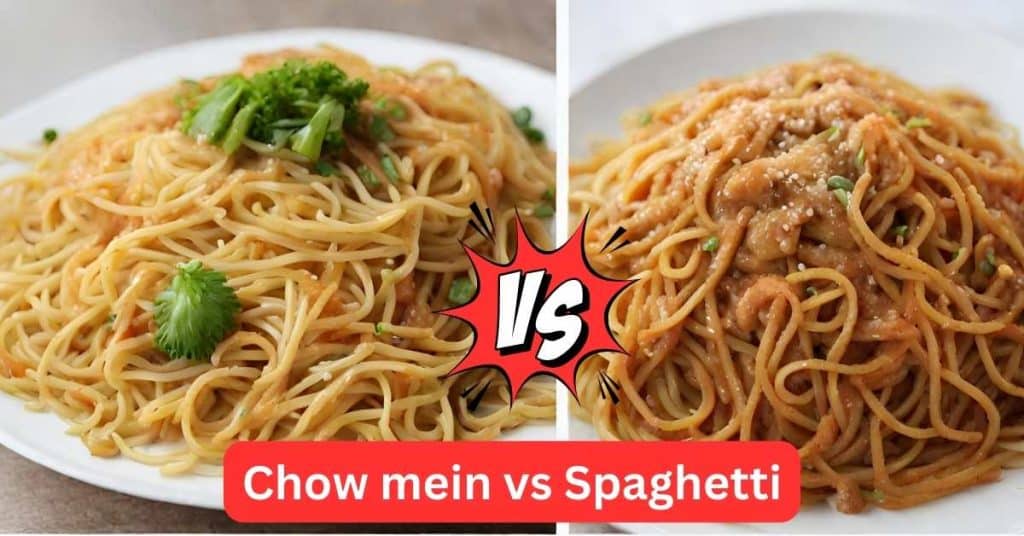Chow mein and spaghetti: two iconic dishes from distinct culinary worlds, each boasting its own unique flavors, textures, and histories. This exploration delves into what sets these two beloved dishes apart, bringing to light their unique characteristics, origins, and cultural significance.
Key Difference Between chow mein and spaghetti
The main difference between chow mein and spaghetti lies in their origins, ingredients, preparation methods, and flavor profiles:
Origin: Chow mein is a Chinese dish, while spaghetti is fundamentally Italian.
Ingredients:
- Chow Mein: Typically uses egg noodles, which are stir-fried with vegetables and often meats like chicken, beef, or seafood. The sauces used are generally soy-based, such as soy sauce and oyster sauce, imparting a distinct Asian flavor.
- Spaghetti: Made from durum wheat semolina, spaghetti is usually served with various sauces like tomato-based (Marinara), cream-based (Alfredo), or oil-based (Aglio e Olio). Spaghetti dishes often include ingredients like garlic, olive oil, cheese, and herbs like basil or oregano, reflecting the Mediterranean palate.
Preparation Methods:
- Chow Mein: Involves stir-frying the noodles with other ingredients, often leading to a slightly crispy texture. The high heat of the wok and quick cooking method are essential for achieving the characteristic ‘wok hei’ or smoky flavor.
- Spaghetti: Generally, the noodles are boiled in water until ‘al dente’ (firm to the bite) and then combined with the sauce. The focus is on the texture of the pasta and the flavor of the sauce, with less emphasis on the method of combining them.
Flavor Profile:
- Chow Mein: Offers a complex mix of flavors, often savory and slightly sweet, with a distinctive umami character from ingredients like soy sauce and sesame oil.
- Spaghetti: The flavor profile varies greatly depending on the sauce, but it typically highlights the freshness and simplicity of ingredients, whether it’s the tanginess of tomatoes, the richness of cheese, or the simplicity of garlic and olive oil.

Chow Mein: A Stir-Fried Delight from China
Chow mein, a staple in Chinese cuisine, is known for its delightful mix of stir-fried noodles, vegetables, and often meat or seafood. The name “chow mein” comes from the Cantonese words “chow” (stir-fried) and “mein” (noodles). This dish’s beauty lies in its versatility and adaptability, making it a favorite across various regions with local variations.
Preparation and Ingredients
Chow mein typically starts with either fresh or dried egg noodles. These noodles are par-boiled, then stir-fried in a wok with a selection of vegetables like cabbage, carrots, and bean sprouts, and often meats like chicken, beef, or shrimp. The hallmark of a good chow mein is the ‘wok hei,’ a unique, smoky flavor imparted by the high heat of the wok. Seasonings include soy sauce, oyster sauce, sesame oil, and sometimes sugar, creating a savory and slightly sweet flavor profile.
Cultural Significance
Chow mein is not just a dish; it’s a representation of Chinese culinary tradition. It embodies the balance and harmony of flavors that is central to Chinese cuisine. In many parts of the world, chow mein has been adapted to suit local tastes, a testament to its global appeal and versatility.
Spaghetti: An Italian Masterpiece
Spaghetti, the famed Italian staple, is celebrated for its simplicity and its ability to showcase the quality of ingredients. Made from durum wheat semolina, spaghetti is one of the most recognized forms of pasta worldwide.
Preparation and Ingredients
Classic spaghetti dishes focus on minimal ingredients with maximum flavor. Traditional spaghetti recipes include spaghetti aglio e olio (garlic and oil), spaghetti alla carbonara (with eggs, cheese, and bacon), and the globally beloved spaghetti Bolognese (with meat sauce). The key to outstanding spaghetti lies in cooking the pasta ‘al dente’ – firm to the bite – and in the quality of the ingredients used in the sauce.
Cultural Significance
Spaghetti holds a special place in Italian cuisine and culture. It’s a dish often associated with home cooking, family gatherings, and the Italian emphasis on quality ingredients and simple cooking techniques. Like chow mein, spaghetti has traversed the globe, adapting to regional tastes and ingredients, yet always retaining its Italian soul.
Comparative Analysis: Texture, Flavor, and Cooking Techniques
While both chow mein and spaghetti involve noodles, their textures and flavors differ significantly. Chow mein noodles, stir-fried and often crispier, contrast with the soft, silky texture of boiled spaghetti. The flavors also differ: chow mein carries the robustness of soy and oyster sauces, while spaghetti often relies on the freshness of its tomato-based or olive oil-based sauces.
Cooking techniques are another point of divergence. Chow mein’s stir-frying in a wok imparts a unique char and flavor, while spaghetti is typically boiled and then mixed with sauce, emphasizing the pasta’s texture and the sauce’s flavor.
Nutritional Aspects
In terms of nutrition, both dishes can be adapted to be healthful. Chow mein can be loaded with vegetables, lean proteins, and controlled in oil to make it a balanced meal. Spaghetti, when made with whole wheat pasta and loaded with vegetable-rich sauces, can also be a nutritious option.
Adaptability and Global Appeal
Both chow mein and spaghetti have crossed their native borders and found a place in hearts worldwide. This global journey has led to countless variations, each reflecting local tastes and ingredients, from the chow mein sandwiches in some American regions to spaghetti with hotdogs popular in parts of Asia.
Chow Mein Recipe
Ingredients:
- 200g egg noodles
- 2 tablespoons vegetable oil
- 1 chicken breast, thinly sliced (optional)
- 1 bell pepper, julienned
- 1 medium carrot, julienned
- 1/2 cup bean sprouts
- 2 green onions, chopped
- 2 cloves garlic, minced
- 1 tablespoon soy sauce
- 1 tablespoon oyster sauce
- 1 teaspoon sesame oil
- Salt and pepper, to taste
Instructions:
- Cook the egg noodles according to package instructions, then drain and set aside.
- Heat 1 tablespoon of oil in a wok or large pan over high heat. Add the chicken slices and stir-fry until cooked through. Remove the chicken and set aside.
- Add the remaining oil to the wok. Stir-fry the garlic, bell pepper, and carrot for 2-3 minutes.
- Add the cooked noodles, chicken, bean sprouts, and green onions to the wok. Toss everything together.
- Pour in the soy sauce, oyster sauce, and sesame oil. Stir-fry for another 2 minutes, ensuring everything is well coated with the sauce.
- Season with salt and pepper to taste. Serve hot.
Spaghetti Recipe
Ingredients:
- 200g spaghetti
- 2 tablespoons olive oil
- 3 cloves garlic, minced
- 1 can (400g) crushed tomatoes
- 1 teaspoon dried basil
- 1 teaspoon dried oregano
- Salt and pepper, to taste
- Grated Parmesan cheese, for serving
- Fresh basil leaves, for garnish
Instructions:
- Cook the spaghetti in a large pot of boiling salted water until al dente, as per package instructions. Drain and set aside.
- In a separate saucepan, heat the olive oil over medium heat. Add the minced garlic and sauté for about 30 seconds, until fragrant.
- Add the crushed tomatoes, basil, and oregano to the saucepan. Simmer the sauce for about 15 minutes, allowing the flavors to meld together. Season with salt and pepper to taste.
- Add the cooked spaghetti to the sauce, tossing to coat the pasta evenly.
- Serve the spaghetti with a sprinkle of grated Parmesan cheese and garnish with fresh basil leaves.
These recipes provide a classic taste of each dish, showcasing the unique flavors and cooking styles of Chinese and Italian cuisines. Enjoy cooking and savoring these delicious meals!
Conclusion: Celebrating Diversity Through Food
Chow mein and spaghetti, each from different corners of the world, tell stories of culture, tradition, and adaptation. They remind us of the power of food to transcend boundaries, bringing people together in the shared experience of cooking and savoring. Whether it’s the smoky stir-fry of a chow mein or the comforting simplicity of a spaghetti dish, these meals continue to delight and unite food enthusiasts across the globe.









Leave a Comment